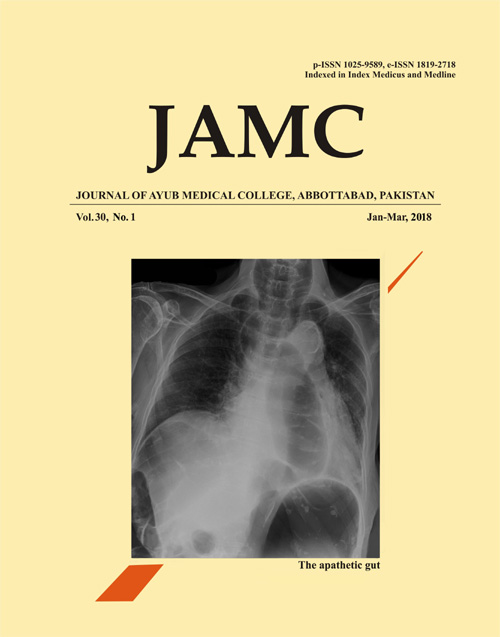CASE OF IATROGENIC CUSHING'S SYNDROME BY TOPICAL TRIAMCINOLONE
Abstract
Cushing's syndrome is a collection of signs and symptoms due to hypercortisolism. Prolong use of topical steroid may cause this syndrome and suppression of hypothalamic and pituitary function, however such events are more common with oral and parenteral route. There are very few cases of Cushing's syndrome with a topical application amongst which triamcinolone is the rarest drug. We report a case of 11-year-old boy is presented who developed Cushing's disease by topical application. The child had body rashes for which the caregiver consulted a local quack, a topical cream of triamcinolone was prescribed. After application for three months, the patient became obese and developed a moon-like face. A thorough biochemical workup and diagnostic test for Cushing's disease was done to confirm. The following case report a dramatic example of development of the syndrome from chronic topical application of the least potent corticosteroid
Keywords: Triamcinolone; Cushing Syndrome; EndocrinologyReferences
CDC. Growth Charts - Data Table of Infant Head Circumference-for-age Charts [Internet]. [cited 2016 Dec 4]. Available from: https://www.cdc.gov/growthcharts/html_charts/hcageinf.htm
NIH. How many people are affected by or at risk for Cushing's syndrome? [Internet]. Eunice Kennedy Shriver National Institute of Child Health and Human Development. [cited 2016 Dec 4]. Available from: https://www.nichd.nih.gov/health/topics/cushing/conditioninfo/pages/risk.aspx
NIH. Cushing's Syndrome. [Internet]. National Institute of Diabetes Digestive and Kidney Diseases. [cited 2016 Dec 4]. Available from: https://www.niddk.nih.gov/health-information/endocrine-diseases/cushings-syndrome#1
WHO. Model Prescribing Information: Drugs Used in Skin Diseases: Annex: Classification of topical corticosteroids [Internet]. [cited 2016 Dec 4]. Available from: http://apps.who.int/medicinedocs/en/d/Jh2918e/32.html
Siklar Z, Bostanci I, Atli O, Dallar Y. An infantile Cushing syndrome due to misuse of topical steroid. Pediatr Dermatol 2004;21(5):561-3.
De Souza A, Strober BE. Principles of topical therapy. In: Freedberg IM, Eisen AZ, Wolff K, Austen KF, Goldsmith LA, Katz SI, et al., editors. Fitzpatrick's Dermatology in General Medicine. 6th ed. New York: Mc Graw-Hill; 2008. p.2643-51.
Tempark T, Phatarakijnirund V, Chatproedprai S, Watcharasindhu S, Suporsilchai V, Wananukul S. Exogenous Cushing's syndrome due to topical corticosteroid application: case report and review literature. Endocrine. 2010;38(3):328-34.
Dhar S, Seth J, Parikh D. Systemic side-effects of topical corticosteroids. Indian J Dermatol 2014;59(5):460-4.
Hengge UR, Ruzicka T, Schwartz RA, Cork MJ. Adverse effects of topical glucocorticosteroids. J Am Acad Dermatol 2006;54(1):1-15.
Curtis JA, Cormode E, Laski B, Toole J, Howard N. Endocrine complications of topical and intralesional corticosteroid therapy. Arch Dis Child 1982;57(3):204-7.
Downloads
Published
How to Cite
Issue
Section
License
Journal of Ayub Medical College, Abbottabad is an OPEN ACCESS JOURNAL which means that all content is FREELY available without charge to all users whether registered with the journal or not. The work published by J Ayub Med Coll Abbottabad is licensed and distributed under the creative commons License CC BY ND Attribution-NoDerivs. Material printed in this journal is OPEN to access, and are FREE for use in academic and research work with proper citation. J Ayub Med Coll Abbottabad accepts only original material for publication with the understanding that except for abstracts, no part of the data has been published or will be submitted for publication elsewhere before appearing in J Ayub Med Coll Abbottabad. The Editorial Board of J Ayub Med Coll Abbottabad makes every effort to ensure the accuracy and authenticity of material printed in J Ayub Med Coll Abbottabad. However, conclusions and statements expressed are views of the authors and do not reflect the opinion/policy of J Ayub Med Coll Abbottabad or the Editorial Board.
USERS are allowed to read, download, copy, distribute, print, search, or link to the full texts of the articles, or use them for any other lawful purpose, without asking prior permission from the publisher or the author. This is in accordance with the BOAI definition of open access.
AUTHORS retain the rights of free downloading/unlimited e-print of full text and sharing/disseminating the article without any restriction, by any means including twitter, scholarly collaboration networks such as ResearchGate, Academia.eu, and social media sites such as Twitter, LinkedIn, Google Scholar and any other professional or academic networking site.










